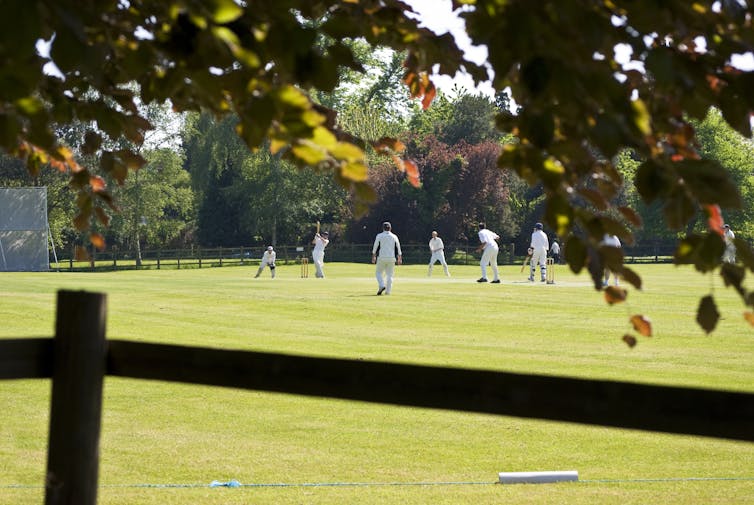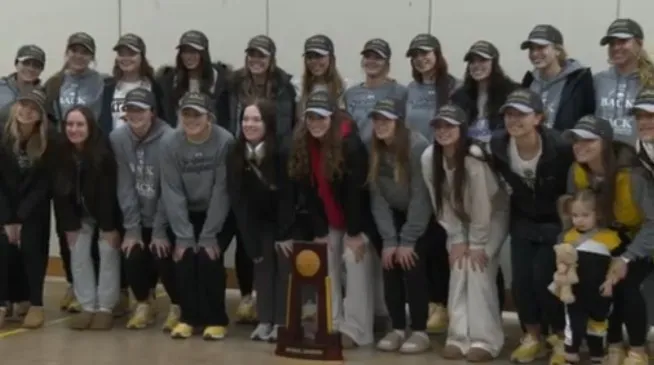Sports
Investment in the Hundred could save UK cricket from a financial sticky wicket


So now, for example, 51% ownership of the Oval Invincibles is in the hands of Surrey CCC. Each hosting county was then given the option of selling their share – and so far Yorkshire and Lancashire have done just that.
But the ECB stood firm. And given the recent investment into the Hundred, it will no doubt feel vindicated.
Overall then, cricket fans may look back on 2025 as a year of major change in the sport in England and Wales. Success is far from guaranteed but the early indications, especially with regards to finance, are overwhelmingly positive.
Yet investment in the future is essential if cricket is to remain relevant and appeal to new audiences. There are already suggestions that Gen Z prefers other sports such as basketball and boxing, over cricket.
Because the cash is sorely needed. Our research shows that CCCs have struggled financially for a while, and are overdue an economic boost.
And while the ECB has hinted at increasing the number of franchises in the future, the worry will still be that some clubs benefit more than others.
Cricket is an old sport that has evolved over centuries. But 2025 is shaping up to be a historic – and lucrative – year for the game in England and Wales.
The total sale of the franchises has generated £550 million, far exceeding expectations. From that, 10% (£55 million) will be ringfenced by the ECB to invest in measures to increase participation in cricket throughout England and Wales.
Established in 2021 by the England and Wales Cricket Board (ECB), the focus of the Hundred was appealing to new audiences who have not engaged with cricket before.
To help with this, the Hundred started off with the ECB owning all eight teams or “franchises” in the league. Now it has sold 49% of each franchise and gifted the remaining 51% to each Hundred-hosting county.
Not everyone is a fan of course, and there has been criticism of the tournament’s design, its addition to an already congested cricket calendar, and the fact that only eight of the 18 county cricket clubs (CCCs) are involved.
With the Hundred, each side gets 100 balls to bowl at their opponent’s wickets. The highest number of runs wins. It’s very simple. And entertaining.
This will probably mean that the Hundred is prioritised over the other formats of domestic cricket – and even international commitments. As many of the high-profile players play across the different formats, they will need to manage their schedules and are likely to choose whatever brings the greatest financial rewards.
Not cricket?
Eventually, this could lead to increasing levels of commercialisation, of the kind sports fans have become accustomed to within English Premier League football.
For the first time, private equity investment has entered the domestic game, changing the business structure of professional cricket forever. The source of this corporate interest – worth around £550 million – is the league of eight teams known as the Hundred.
A slightly complicated division of the rest of the spoils then basically leaves each Hundred-hosting county cricket club with £18 million (plus the 51% ownership of the franchise). The non-hosting CCCs will receive around £32 million each.

Graeme Dawes/Shutterstock
The commercial interest now stretches towards international markets and other sports. Four of the investment groups now involved in the Hundred are owners of Indian Premier League cricket franchises, while others are linked to the worlds of professional football (Birmingham Phoenix and Birmingham City FC) and Silicon Valley (London Spirit).
Investment must also be used to improve stadium infrastructure and facilities, to attract good crowds and to generate the superstars of the future. But the influx of money means the Hundred is likely to dominate the broadcast schedule, and prioritising the tournament in this way may alienate some more traditionally minded fans.
And that was probably the point of the whole exercise. It might not be cricket as it used to be – but as with other sports today, many of the biggest decisions come down to whether or not they make money.
But it’s not all good news, as the influence of private equity may cause internal conflicts about a CCC’s strategy. For while the ECB has said it will remain in control of the Hundred as a competition, the primary goal of the franchise sales is to achieve a return for investors.
It is a much shorter format than traditional forms of the game such as the four-day County Championship competition, or the One Day Cup, which is made up of 50 overs (300 balls) per side.
For context, in 2023, Surrey CCC had the highest revenue at £65 million, while Leicestershire had the lowest at £5.5 million. So a one-off injection of £18 million would represent significant growth for clubs across the scale.
Sports
Kentucky set to host volleyball regional

LEXINGTON, Ky. — The University of Kentucky is hosting the 2025 NCAA Volleyball Lexington Regional. Matches will be played Thursday and Saturday at Memorial Coliseum.
Top-seeded Kentucky opens play Thursday afternoon at 3:30 p.m. ET against Cal Poly, who beat the No. 4 seed USC in five sets Friday to advance. In the regional’s opening match, second-seeded Arizona State will play third-seeded Creighton at 1 p.m. ET. ESPN2 will have live coverage of the matches Thursday, with both also shown live on the ESPN app. The two winners of Thursday’s matches will meet Saturday afternoon in the regional final, with the winner advancing to the NCAA Final Four the following weekend in Kansas City, Missouri. The Lexington Regional final on Saturday will be aired live on the ESPN networks, with a time to be announced Thursday.
All-session tickets for the 2025 Lexington Regional go on sale Monday at 10 a.m. ET through UK Athletics by calling the ticket office at 859-257-3838 or visiting the ticket office in the Joe Craft Center. Fans interested in purchasing single-session tickets can acquire those tickets beginning at 10 a.m. ET Tuesday. One ticket will get fans into both regional semifinal matches Thursday.
2025 NCAA Volleyball Lexington Regional Memorial Coliseum — Lexington, Ky.
Thursday, Dec. 11
- Match 1: 1 p.m. ET — (2) Arizona State vs. (3) Creighton [ESPN2]
- Match 2: 3:30 p.m. ET — (1) Kentucky vs. Cal Poly [ESPN2]
Saturday, Dec. 13
- Match 3: Time TBA — Winner Match 1 vs. Winner Match 2 [TV TBA] — Winner advances to NCAA Final Four
Sports
El Paso volleyball player Giselle Gandara named MaxPreps All-American
Dec. 7, 2025, 9:15 a.m. MT

Eastlake High School volleyball player Giselle Gandara has been named to the MaxPreps Freshman All-American volleyball team.
The 5-9 outside hitter had 427 kills, 378 digs, 66 blocks and 53 aces for the Falcons, who finished 36-5 and won two playoff matches this past season. She is one of five Texas players on the 20-person team.
“Giselle is a fantastic player,” Eastlake coach Roel DeAnda said. “She has a strong work ethic and her future is bright. It’ll be great to see her compete in the next three years.”

Gandara’s sister, Genna, is the setter for Eastlake and is a junior.
“To see Giselle’s growth as player has been amazing,” Genna said. “She’s hard working and plays with confidence,”
Added Giselle: “It was a blessing for the great season we had as a team. Playing alongside my sister Genna helped me so much, I learned a great deal from here. I wanted to make an impact as a freshman. I wanted to prove people wrong this year and that I could play at a high level. We had an amazing team and beating Keller in the playoffs was a special moment.”
Felix F. Chavez can be reached at fchavez@elpasotimes.com; @Fchavezeptimes on X
Sports
Bump, set, spike: Dinos teach students of all skill levels volleyball during unique one day camp

For the average junior high student, volleyball can be a counterintuitive and hard-to-learn sport. By partnering with the Calgary Dinos Men’s Volleyball team, Andy Brar, a Teacher at Dr. Gordon Higgins School, hopes to break as many of those barriers as he can.
For a one day camp, players and coaches from the Calgary Dinos Men’s volleyball team visited the Dr. Gordon Higgins junior high school for a three-hour, two section volleyball camp, at no cost to the school or the students.
“It’s the culmination of two individuals coming together and really highlighting the beauty of their two institutions, for example, the University of Calgary and their esteemed athletic program and the beautiful diversity that exists in a northeast school like this,” Brar told LWC.
With attendance set through an open sign up, Brar said he encouraged students who are unfamiliar with volleyball to attend, as volleyball, though the root of the event, was only a piece of the camp.
“The hope for this camp would be to take these skills and apply them to their everyday life, but also to understand the next time I’m faced with the challenge or I haven’t done something before to step up and jump on opportunities,” he said.
Life skills aside, Brar valued a camp of this caliber, having university level athletes and a former Olympian as instructors at over $20,000 per student. The camp offered a unique opportunity to learn from the best, especially for the students who may have less experience with the sport.
“If you give students confidence months in advance of tryouts, you’re exposing them to a new sport. When that individual who’s giving the instruction is a two-time Olympian, it really highlights the importance of the sport and the underlying commitments of teamwork, communication and building togetherness,” Brar said.
The Olympian in question, second-year Dinos’ head coach Graham Vigrass, said the opportunity was equally valuable for the Dinos team, especially at this point in the season.
“I was excited to see how much fun our guys are having. It’s a time of the year that they’re a bit burnt out from all the practices and matches that we have and this is a bit of a refresh and gets back to their love of the game,” said Vigrass, who represented Canada at the Olympics in 2016 and 2020.
“They see kids that are pumped and excited to see them and get their autographs, I hope that it makes them understand why they fell in love with the game when they were this age, because it’s kind of easy to forget it.”
Brar, who recently was honoured with the 2025 Prime Minister’s Award for Teaching Excellence, hopes the camps can become a somewhat regular thing for his students, a feeling reciprocated by Vigrass.
“This is the first time we’ve done (a camp like this). I’m a newer coach at U of C, but this is a huge priority of mine, is to get out to community and ideally, to communities like this that don’t necessarily have that same opportunity as some others in Calgary,” he said.
Sports
UW-Oshkosh volleyball celebrates first national championship | WFRV Local 5

(WFRV) – The UW-Oshkosh women’s volleyball team returned to campus as national champions for the first time in program history, welcomed home by a crowd of celebrating fans.
The Titans capped a dominant postseason run with a 3–0 sweep of No. 5 La Verne in the NCAA Division III title match — completing the tournament without dropping a single set on their way to the crown.
For reaction from the team, click the video above for the full story.
Sports
Is AI taking jobs from college graduates? Here’s what to know

As artificial intelligence continues to make appearances in almost all aspects of our lives, there have been rising concerns for whether it’s taking jobs, especially those of new college graduates entering the labor market.
Colorado State University student Eleanora Proffitt said AI has caused her to worry for the future in an already tight labor market.
“We’re already in a job shortage,” Proffitt said. “AI should be helping us, … not taking our jobs away.”
The unemployment rate of newly graduated college students reached its highest percentage since July 2021 — 5.8% — in April, according to a report by the Federal Reserve Bank of New York. This number, compared to an unemployment rate of 4% for all workers that same month, has raised some alarms regarding AI’s impact.
Oxford Economics, a global economic advisory firm, stated in a recent report that “there are signs that entry-level positions are being displaced by artificial intelligence at higher rates.”
Various job sectors have been affected by AI differently. A working paper published by Stanford Digital Economy Lab found that between late 2022 and July 2025, areas of employment for young workers in software engineering, which SDEL referred to as an “AI-exposed occupation,” has declined by nearly 20%.
Other fields such as customer service, accounting and auditing, secretarial and administrative work, computer programming and sales revealed a similar pattern, according to the paper.
According to CNBC, Some major firms and companies such as JPMorgan Chase, Amazon and Walmart are starting to make the switch to AI for lower-level white-collar jobs because of its cheaper price and supposed efficiency. However, there are still many findings that claim AI is not a major component regarding recent unemployment rates for all recent college graduates.
“Will (AI) take jobs? Yes,” said Martin Shields, a Colorado State University professor of economics. “Will it take all the jobs? Certainly not. And will it create a lot of opportunities? Yes, it will.”
According to an article by The Budget Lab at Yale, the broader labor market has not been hugely disrupted since the release of ChatGPT — a popular AI chatbot developed by OpenAI. The lab notes that an impact on the labor market is likely to take much longer than just 33 months and can take decades to fully settle in.
A current trend in the labor market is that fewer people are quitting their jobs, and fewer employers are hiring because of economic uncertainty. This is known as a labor market tightening, which poses an even greater challenge for fresh college graduates trying to get their foot in the door.
Adjustments to technological progress has been done throughout history and are expected to a certain degree, but some are concerned that job losses may look a little different now, as AI is replacing jobs that were generally thought of as “safe.” Despite the current state of the job market, the Future of Jobs Report 2025 by World Economic Forum estimated that although AI could displace 92 million jobs by 2030, it could add 170 million new ones.
These positions could be in areas of AI development, research and safety, as well as robotics.
“People who can use the technology, lead the use of this technology, communicate it, can check it, can ask it the right questions — those people will thrive with that skill set,” Shields said.
A report by Lightcast, a labor insight platform, found that in an analysis of over 1.3 billion job postings, there has been a surge in demand for AI skills — and higher average pay for jobs that required them.
CSU alumnus and Chief Operating Officer for ZenRows, a web data company, Robert Mata said he has been in tech for 15 years and pays close attention to AI usage when hiring. Mata is not just interested in whether new hires use AI, but more so how they use the tool in the context of the role they are applying for.
“It goes way beyond, ‘Hey, do you use AI daily for X, Y, Z?’” Mata said. “It really depends on the role and the usage of AI.”
Mata said he has had to assess how potential candidates for various positions utilize AI. For example, he asks applicants for sales positions how they use AI to better find leads, source data, acquire contact information and more.
Taking on the potential growth and challenges brought by AI, CSU has begun integrating AI literacy into higher education. The webpage titled AI @ CSU has news related to AI, resources for learning how to use AI and pages describing the institution’s mission and vision with AI.
CSU also offers a range of classes available to students who wish to expand their skills in AI, with more to come. As the job market adjusts to new technology, experts suggested that no matter what field students dream of working in, learning how to better navigate AI and use it as a tool are what experts and the job market are alluding to as crucial in this job climate.
“Let’s use this tool,” Shields said. “Let’s recognize its limitations. Let’s recognize that there are a lot of things that we can do that it can’t and hone in on those skills.”
Reach Katya Arzubi at news@collegian.com or on social media @RMCollegian.
Sports
Kenlee Barnard leads Courier & Press 2025 All-Metro volleyball team
Dec. 8, 2025, 3:02 a.m. CT
EVANSVILLE — Ashley Kaczmarski remembers when everything clicked into place this season.
Her North High School volleyball team was on the road at Heritage Hills. The Huskies lost the second set to the eventual sectional champions. Kaczmarski sensed her group was off that evening — none moreso than star setter Kenlee Barnard.
The coach pulled her senior captain aside during the break with a message: the team needed her. What transpired that night, and by extension the rest of the season, summed up what many in the program already knew. Barnard was going to lead the way.
-

 Rec Sports2 weeks ago
Rec Sports2 weeks agoFirst Tee Winter Registration is open
-

 Rec Sports2 weeks ago
Rec Sports2 weeks agoFargo girl, 13, dies after collapsing during school basketball game – Grand Forks Herald
-

 Motorsports2 weeks ago
Motorsports2 weeks agoCPG Brands Like Allegra Are Betting on F1 for the First Time
-

 Sports3 weeks ago
Sports3 weeks agoVolleyball Recaps – November 18
-

 Motorsports2 weeks ago
Motorsports2 weeks agoF1 Las Vegas: Verstappen win, Norris and Piastri DQ tighten 2025 title fight
-

 Sports2 weeks ago
Sports2 weeks agoTwo Pro Volleyball Leagues Serve Up Plans for Minnesota Teams
-

 Sports2 weeks ago
Sports2 weeks agoUtah State Announces 2025-26 Indoor Track & Field Schedule
-

 Sports2 weeks ago
Sports2 weeks agoSycamores unveil 2026 track and field schedule
-

 Motorsports2 weeks ago
Motorsports2 weeks agoRedemption Means First Pro Stock World Championship for Dallas Glenn
-

 NIL1 week ago
NIL1 week agoBowl Projections: ESPN predicts 12-team College Football Playoff bracket, full bowl slate after Week 14






















































